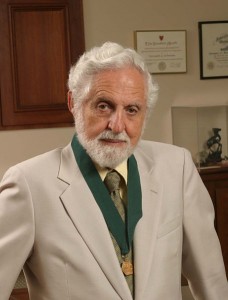
Carl Djerassi photo courtesy of Chemical Heritage Foundation
Sixty-two years ago, in a small laboratory in Mexico City, the world changed for chemists, biologists and, most of all, women.
That’s when, on Oct. 15, 1951, Carl Djerassi became the first to synthesize the hormone norethindrone, known today as an essential ingredient in the oral contraceptive pill. Djerassi passed away this week at 91 years old. Given Djerassi’s immense contributions to science, politics, philosophy, and literature, it is a fitting time to pay tribute to “the father of the Pill” and look at how far one molecule has come in the last several decades.
By changing a single carbon atom to a hydrogen atom, Djerassi produced the first synthetic version of the hormone progesterone (‘progestin’ refers to the synthetic version). While it was previously known that estrogen and progesterone are key hormones in female reproduction, these compounds turned out to be inefficient and expensive to synthesize from animal and plant extracts, making Djerassi’s synthesis all the more exciting. We also now know that progesterone itself has low bioavailability when taken orally, meaning that the drug is metabolized before being absorbed into the system, with little to no effects observed.
Initially developed as a potential drug for menstrual disorders, infertility treatment, and cervical cancer treatment, norithindrone was reimagined as a contraceptive by biologist Gregory Pincus and gynecologist John Rock in the 1960s. Shortly after the new synthetic progesterone materialized into a birth control pill, an American Chemical Society paper deemed its biochemistry “largely unknown,” though the paper mentions that fertility hormones, carbohydrate metabolism, and possibly the pattern of cholesterol metabolism had the potential to be altered significantly. At this point in time little was known about steroid metabolism, making studies even more complicated, as progestin belongs to a class of steroid molecule naturally produced in the body. The paper also mentioned “effects of the synthetic estrogens-mestranol and ethynylestradiol are a little less fuzzy,” giving insight into how little was known about these revolutionary drugs at the time.
However, early worries about widespread metabolic effects from the drug were not completely unsubstantiated, and later studies indicated that carbohydrate metabolism could indeed be impaired by oral contraceptives. It was found that the formulation of the pill is essential for minimizing metabolic disturbances. Triphasic pills have been shown to have the lowest effect on overall metabolism, so that there are three different doses of separate hormones instead of taking a larger dose of a single hormone. However today, countless other progestins have been synthesized and optimized. A currently used second-generation progestin, levonorgestrel, has been designed have high affinity for the progesterone receptor which reduces potential side effects. At the low dosage that contraceptives necessitate no other cholesterol pathways are perturbed, and the compound has high oral bioavailability.
Today the effects of progestin contraceptives have been fully explored, with side effects well documented via hundreds of studies. Used by more than 100 million women worldwide, there are a wide variety of formulations available, as well as different mechanisms of exposure to the drug. The synthesis of norethindrone was a game-changer for the general public and the medical field, and remains just as relevant and essential today as it did in 1951.
